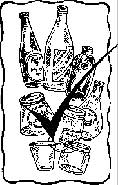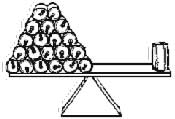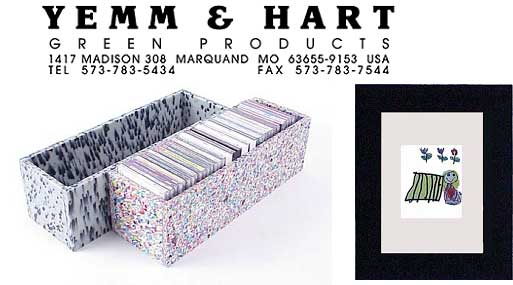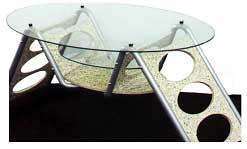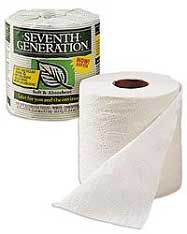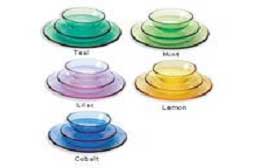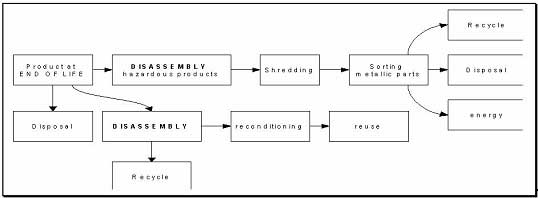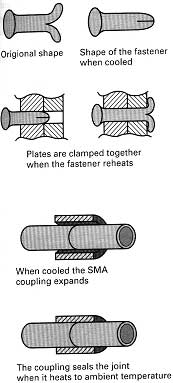|
Sustainable Design Awards Toolkit
Section 2.4 Recycling An overview of the process: How people respond to recycled materials (taken from www.wastewatch.co.uk): Myth: Recycled products are poor quality. Reality: False. Aluminium and glass can be recycled repeatedly without a loss in quality. Paper does suffer a reduction in quality as paper fibres shorten with each reprocessing which limits the number of times it can be recycled. But high quality paper is readily available and lower grades of paper are suitable for many uses. Throughout the world, military and commercial aircraft use retread tyres, as do time-critical courier services such as Federal Express. Myth: Recycled products are too expensive. Reality: Recycled products should not cost more but for some product areas economies of scale do result in higher prices. That is why creating consumer demand is so important to help lower prices. Myth: Recycled products are not attractive. Reality: Gone are the days of grey and grainy recycled paper. For many items it is impossible to distinguish between recycled and non-recycled items. Myth: Recycled products consume more energy and resources than a product made from primary materials. Reality: False. Many recycled materials offer significant savings in terms of energy and water as well as reductions in resource use. For example, manufacturing 1 tonne of recycled paper results in 74% less air pollution and 34% less water pollution than manufacturing a tonne of paper from virgin wood pulp. Negative experience in the past with recycled products reinforces the inertia. The view that "we have always bought that product, so why change now?" is commonly expressed. Combating these myths and prejudices can be accelerated through the provision of accurate information, good practice case studies, demonstration projects and a supportive national framework. Plastics have a maximum recycled polymer content. This content will be smaller for more structural items such as furniture and bigger for items such as plastic bags. This is because the recycled polymer may be slightly contaminated. Also, as the polymer is recycled its properties will be changed by the process. If too much recycled content is used fatigue can lead to the material breaking. Sometimes legislation will state that recycled plastic has to be laminated with a layer of virgin plastic. This often occurs in food packaging.
There are two types of recycling: closed loop and open loop. For closed-loop recycling the producer has to collect the products when they are due to be thrown away. This can be done through good consumer collection strategies, for example renting the product or giving the consumer money for the products' return. A more popular route involves recycling the waste produced during the manufacturing process. Production waste, for example faulty mouldings, offcuts or flash that may have to be cut off each product when it is removed from the mould, is easily collected. The producer can then recycle the collected polymer and use the resulting recycled material to produce the same product. Open-loop recycling uses recycled material gained from a variety of sources such as recycled polymer sheet suppliers or through municipal waste. The recycled polymer is then used to produce new unrelated products. Material Recycling - Closed- Loop Recycling Factories will often recycle plastic that is wasted due to problems such as flash or runners produced during component production. Other examples include:
Paper, steel cans, milk and juice carton and plastic recycling are also very popular. Many businesses also directly recycle their products at their end of lives: "Canon Business machines began recovering its more than 20 million used laser-printer toner cartridges by working with a national delivery service to develop a U.S. collection system. Cartridges are disassembled and combined with virgin material to produce new units. GE Plastics buys back plastic material in flake or pellet form, provided it is processed by acceptable regrind specifications and procedures." (Machine Design, Feb 1993.)
Material Recycling � Open-Loop Recycling
Yemm+Hart are primarily a supplier of recycled sheet materials. They have used their own sheets to produce products such as CD storage boxes, clipboards and cutting boards from recycled polymers. They use the multicoloured �speckled� qualities of the material to add to the aesthetic qualities of the design. They also recycle more unusual materials; the picture frame above right is laminated with recycled worn out car tyres. Source: www.yemmhart.com Smile Plastics is their UK competitor. �Smile Plastics is committed to sourcing and developing innovative ideas and markets for recycled materials, concentrating on transforming plastics waste into multicoloured sheets.� Examples of recycled materials can be found on their website ( http://www.smile-plastics.co.uk)
"The design of a small coffee table using recycled polymers in a subtle and elegant manner. The design aims to combine the visual qualities of the glass with the striking pattern of the recycled polymer. The elliptical form is followed throughout the design creating a uniform feel to both materials." Taken from 2nd and 3rd year student work designing with recycled polymers from Made of Waste Ltd � Loughborough University Department of Design and Technology, 1999 Composting:
Composting your food scraps and garden trimmings reduces the amount of waste that needs to be disposed of. It also provides you with free rich soil that would otherwise have to be transported to your house. Using compost can also greatly reduce the need for water, fertilisers and pesticides.
The Remarkable Recycled Pen is made from a single plastic coffee cup. It also lasts four times longer than most other ballpoints. Source: www.biothinking.com
Disassembling products for recycling What can happen at a product's end of life:
Disassembly computer aids Ametide � A MEthodology for TIme Disassembly Estimation. In association with Renault, the consortium on green design and manufacturing and 3S: "Given that disassembly techniques, which include a lot of destructive methods, are improving all the time, we assumed that designer has no time to update his knowledge in disassembly. To prevent this we set up a database easily updated from where we extract all the disassembly techniques available corresponding to a fastener. Thus the designer gets the panel of all possibilities for removing a part and can choose which is the best depending on what the part is disassembled for." A typical screen from the programme. Gives component name, mass and material type; the fastening system used; pollution; method of disassembly and disassembly time: Source: http://greenmfg.me.berkeley.edu/green/cad/ametide 
SMART materials
|
||||||||||||||||||||||||||||||||||||||||||||||||||||||||||||||
Ecodesign Tools
|
|||||||||||
| � | |||||||||||
Toolkit Index
  |

